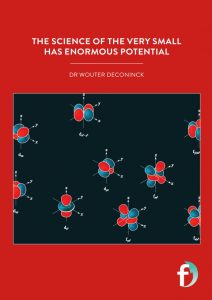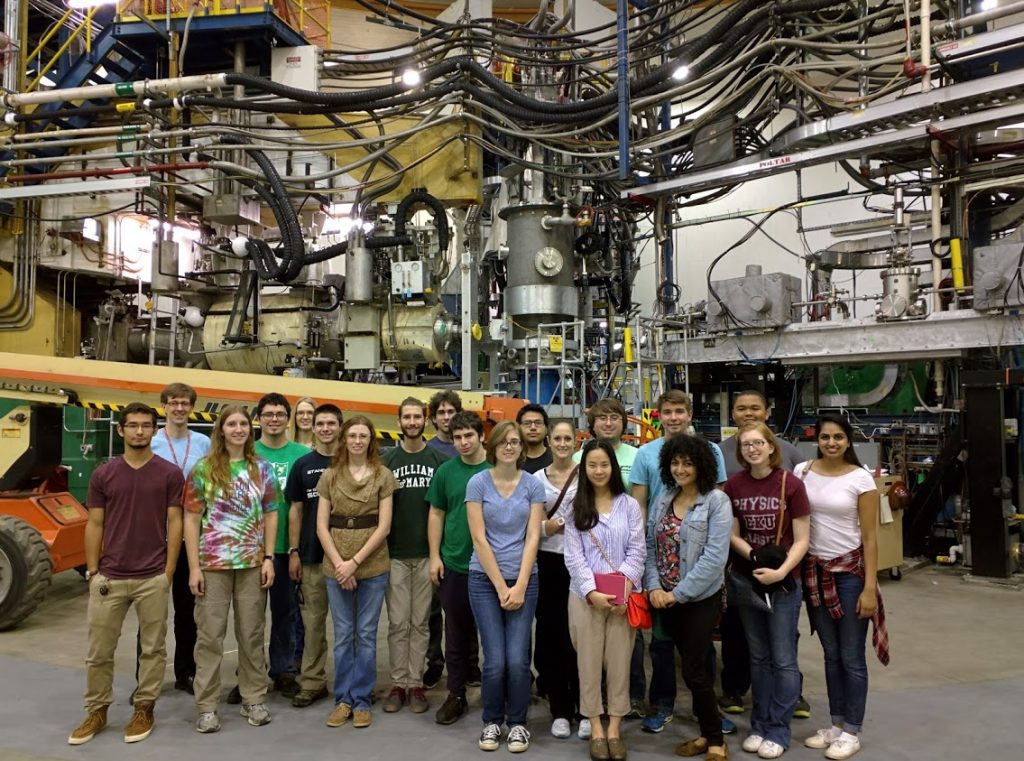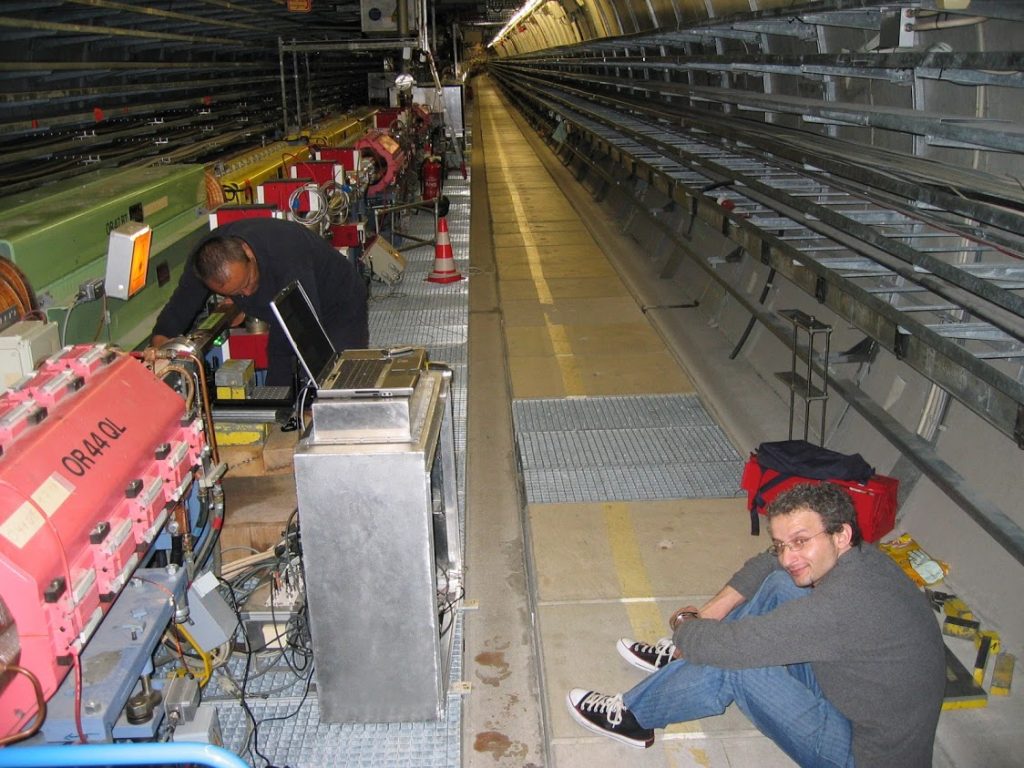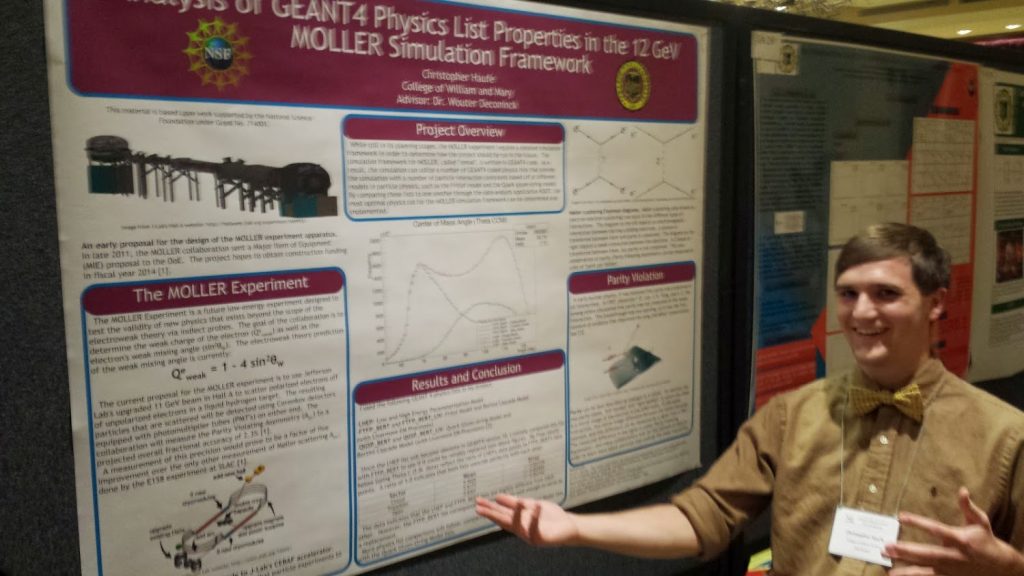The science of the very small has enormous potential
Dr Wouter Deconinck, based at the University of Manitoba in Canada, is part of the team working on the Electron-Ion Collider. Once built, the machine will be able to look inside the atomic nucleus, its protons and neutrons, and help to power the technologies of the future
TALK LIKE A SUBATOMIC PHYSICIST
PARTICLE ACCELERATOR
A machine that uses electromagnetic fields to propel charged particles to very high speeds and energies
PARTICLE COLLIDER
A type of particle accelerator that accelerates two beams of particles and lets them impact on one another
ELECTRONS
Subatomic particles that orbit the nucleus of an atom
NUCLEUS
The small, dense region consisting of protons and neutrons at the centre of an atom
PROTONS
Subatomic particles with a positive charge that are found in the atomic nucleus
NEUTRONS
Subatomic particles with no electric charge and a mass slightly greater than that of a proton
IONS
A charged atom or molecule
QUARK
An elementary particle inside protons and neutrons that is a fundamental constituent of matter
GLUONS
An elementary particle that acts as the exchange particle for the strong force between quarks
SUPERCONDUCTING MAGNETS
An electromagnet made from coils of superconducting wire that must be cooled to cryogenic temperatures during operation
Subatomic physicists are interested in understanding exactly what is happening at inconceivably small scales. For instance, researchers might work to study protons, ions and nuclei in much the same way as a biologist might study the structure of a leaf. To achieve this, a biologist will use a microscope to magnify the subject of their investigations. However, while the cells that compose a leaf are small, protons, ions and nuclei are even smaller, so studying the structures of an atom requires machinery that is far more complex than a microscope.
Observing things at these scales requires the use of light, but rather than using visible light we might get from a light bulb, scientists have to use particle accelerator beams. Instead of optical lenses, which direct light into a human’s eye, subatomic physicists use magnets, which focus the particles onto particle detectors. Performing this function requires a particle accelerator, of which there are very few in the world. One of the most notable was the HERA accelerator in Germany, which ran for 15 years (up to 2007) and was the world’s most precise electron microscope.
Although the data gathered from HERA are still being used for particle physics experiments, there is a need to develop and build a new particle accelerator. Dr Wouter Deconinck, based at the University of Manitoba in Canada, is currently working on a new particle accelerator that will shed some light on the inner workings of atoms.
WHAT MAKES THIS NEW PARTICLE ACCELERATOR SPECIAL?
The accelerator is called the Electron-Ion Collider (EIC) and will be the only functioning electron-proton collider once it has been completed (the only previous one was the aforementioned HERA accelerator). EIC will use very intense polarised beams to allow scientists to make precise measurements at the atomic scale. Advances in accelerator technology mean that electron-proton collisions can be created, collisions which are 100 times as bright as the collisions that were previously made at the HERA collider! EIC will be able to ensure that bunches of particles in two colliding beams can rotate in the right way to be perfectly overlapping when they are at the interacting point.
WHAT IS WOUTER’S ROLE IN THE PROJECT?
When Wouter was at graduate school, he actually worked at the HERA accelerator, studying measurements of the polarisation of electron beams, so he has extensive experience working in this field. During the years that EIC has been designed and developed, Wouter has expanded his research focus to include physics processes that rely on precise polarisation measurements. “I am interested in so-called precision electroweak observables, which are very precise measurements that typically rely on polarised beams and which are sensitive to the indirect effects of new particles,” explains Wouter. “Since particle physics produces large amounts of data that are analysed by large groups of scientists, we have to think carefully about the design of our analysis software.” Wouter is, therefore, one of the members of the EIC software working group which tries to make sure that the software that is being developed for the accelerator will still be functioning until at least 2040.
HOW WILL THE EIC PROJECT REVOLUTIONISE OUR UNDERSTANDING?
EIC will, for the first time, enable scientists to build a collider where both the electron and the proton can be polarised; the intensity of the collisions will be so high that specific studies of the proton structure will be possible. It will also be the first collider where electrons can collide with polarised ions such as deuterium or helium. “What we hope to achieve with the EIC is ‘tomography’ of the proton. Think of a medical scan (MRI or CT), but now apply that to a proton: we will be able to look at slices of the proton, both along the beam direction and in the direction transverse to beam direction,” says Wouter. “We will even be able to look at the impact of the polarisation on these pictures. Finally, because we can accelerate ions, which also contain neutrons, we are not limited to studying the proton, but we can study the neutron just as well.”
WHAT ARE WOUTER’S HOPES AND EXPECTATIONS FOR THE PROJECT?
Wouter is most excited about the prospect of measuring the electroweak mixing angle, which is a fundamental property of the weak force that can describe, for example, the beta decay of radioactive nuclei. It is the least familiar of the four fundamental forces, so the potential for developing new knowledge is enormous. Particle accelerators are used in a wide range of fields, such as cancer therapies or implanting ions into the chips in smartphones. “While nuclear and particle physics research aims to answer big questions about the universe, it is also the perfect training ground for future inventors of new technologies, or cures to diseases,” explains Wouter. “I hope that among the hundreds of students who will work on EIC there will be many who go on to build the innovations of the future, whether they are potential cures to cancer, new medical imaging techniques, or even the next generation of the internet.”
So, if you are interested in becoming part of the next generation, making a real difference to the world in which we live, subatomic physics might be your calling!
 DR WOUTER DECONINCK
DR WOUTER DECONINCK
Associate Professor, Department of
Physics and Astronomy, University of
Manitoba, Canada.
FIELD OF RESEARCH: Subatomic Physics
RESEARCH: Wouter is one of the members of the Electron-Ion Collider’s software working groups. His research is concerned with ensuring that the software developed for the particle accelerator will still be functional and usable until at least 2040.
FUNDERS: Natural Sciences and Engineering Research Council of Canada (NSERC), United States Department of Energy (DOE), Brookhaven National Laboratory (BNL) and Jefferson Lab (JLab).
This material is based upon work supported by the Natural Sciences and Engineering Research Council of Canada (NSERC) and by the National Science Foundation under Grant No. 1714792.
Reference
https://doi.org/10.33424/FUTURUM90
TALK LIKE A SUBATOMIC PHYSICIST
PARTICLE ACCELERATOR
A machine that uses electromagnetic fields to propel charged particles to very high speeds and energies
PARTICLE COLLIDER
A type of particle accelerator that accelerates two beams of particles and lets them impact on one another
ELECTRONS
Subatomic particles that orbit the nucleus of an atom
NUCLEUS
The small, dense region consisting of protons and neutrons at the centre of an atom
PROTONS
Subatomic particles with a positive charge that are found in the atomic nucleus
NEUTRONS
Subatomic particles with no electric charge and a mass slightly greater than that of a proton
IONS
A charged atom or molecule
QUARK
An elementary particle inside protons and neutrons that is a fundamental constituent of matter
GLUONS
An elementary particle that acts as the exchange particle for the strong force between quarks
SUPERCONDUCTING MAGNETS
An electromagnet made from coils of superconducting wire that must be cooled to cryogenic temperatures during operation
Subatomic physicists are interested in understanding exactly what is happening at inconceivably small scales. For instance, researchers might work to study protons, ions and nuclei in much the same way as a biologist might study the structure of a leaf. To achieve this, a biologist will use a microscope to magnify the subject of their investigations. However, while the cells that compose a leaf are small, protons, ions and nuclei are even smaller, so studying the structures of an atom requires machinery that is far more complex than a microscope.
Observing things at these scales requires the use of light, but rather than using visible light we might get from a light bulb, scientists have to use particle accelerator beams. Instead of optical lenses, which direct light into a human’s eye, subatomic physicists use magnets, which focus the particles onto particle detectors. Performing this function requires a particle accelerator, of which there are very few in the world. One of the most notable was the HERA accelerator in Germany, which ran for 15 years (up to 2007) and was the world’s most precise electron microscope.
Although the data gathered from HERA are still being used for particle physics experiments, there is a need to develop and build a new particle accelerator. Dr Wouter Deconinck, based at the University of Manitoba in Canada, is currently working on a new particle accelerator that will shed some light on the inner workings of atoms.
WHAT MAKES THIS NEW PARTICLE ACCELERATOR SPECIAL?
The accelerator is called the Electron- Ion Collider (EIC) and will be the only functioning electron-proton collider once it has been completed (the only previous one was the aforementioned HERA accelerator). EIC will use very intense polarised beams to allow scientists to make precise measurements at the atomic scale. Advances in accelerator technology mean that electron-proton collisions can be created, collisions which are 100 times as bright as the collisions that were previously made at the HERA collider! EIC will be able to ensure that bunches of particles in two colliding beams can rotate in the right way to be perfectly overlapping when they are at the interacting point.
WHAT IS WOUTER’S ROLE IN THE PROJECT?
When Wouter was at graduate school, he actually worked at the HERA accelerator, studying measurements of the polarisation of electron beams, so he has extensive experience working in this field. During the years that EIC has been designed and developed, Wouter has expanded his research focus to include physics processes that rely on precise polarisation measurements. “I am interested in so-called precision electroweak observables, which are very precise measurements that typically rely on polarised beams and which are sensitive to the indirect effects of new particles,” explains Wouter. “Since particle physics produces large amounts of data that are analysed by large groups of scientists, we have to think carefully about the design of our analysis software.” Wouter is, therefore, one of the members of the EIC software working group which tries to make sure that the software that is being developed for the accelerator will still be functioning until at least 2040.
HOW WILL THE EIC PROJECT REVOLUTIONISE OUR UNDERSTANDING?
EIC will, for the first time, enable scientists to build a collider where both the electron and the proton can be polarised; the intensity of the collisions will be so high that specific studies of the proton structure will be possible. It will also be the first collider where electrons can collide with polarised ions such as deuterium or helium. “What we hope to achieve with the EIC is ‘tomography’ of the proton. Think of a medical scan (MRI or CT), but now apply that to a proton: we will be able to look at slices of the proton, both along the beam direction and in the direction transverse to beam direction,” says Wouter. “We will even be able to look at the impact of the polarisation on these pictures. Finally, because we can accelerate ions, which also contain neutrons, we are not limited to studying the proton, but we can study the neutron just as well.”
WHAT ARE WOUTER’S HOPES AND EXPECTATIONS FOR THE PROJECT?
Wouter is most excited about the prospect of measuring the electroweak mixing angle, which is a fundamental property of the weak force that can describe, for example, the beta decay of radioactive nuclei. It is the least familiar of the four fundamental forces, so the potential for developing new knowledge is enormous. Particle accelerators are used in a wide range of fields, such as cancer therapies or implanting ions into the chips in smartphones. “While nuclear and particle physics research aims to answer big questions about the universe, it is also the perfect training ground for future inventors of new technologies, or cures to diseases,” explains Wouter. “I hope that among the hundreds of students who will work on EIC there will be many who go on to build the innovations of the future, whether they are potential cures to cancer, new medical imaging techniques, or even the next generation of the internet.”
So, if you are interested in becoming part of the next generation, making a real difference to the world in which we live, subatomic physics might be your calling!
 DR WOUTER DECONINCK
DR WOUTER DECONINCK
Associate Professor, Department of
Physics and Astronomy, University of
Manitoba, Canada.
FIELD OF RESEARCH: Subatomic Physics
RESEARCH: Wouter is one of the members of the Electron-Ion Collider’s software working groups. His research is concerned with ensuring that the software developed for the particle accelerator will still be functional and usable until at least 2040.
FUNDERS: Natural Sciences and Engineering
Research Council of Canada (NSERC), United States Department of Energy (DOE), Brookhaven National Laboratory (BNL) and Jefferson Lab (JLab).
This material is based upon work supported by the Natural Sciences and Engineering Research Council of Canada (NSERC) and by the National Science Foundation under Grant No. 1714792.
ABOUT SUBATOMIC PHYSICS
Subatomic physics is the science of the small. The very small. Atoms are the smallest unit of matter that form chemical elements, typically measuring around 100 picometres across. To put that in context, one picometre is one trillionth of a metre – you would be able to get billions of them onto the head of a pin, although quite why you would want to is another matter!
WHAT IS REWARDING AND CHALLENGING ABOUT PHYSICS?
Of course, as with any branch of physics, the language of mathematics is of paramount importance. Many concepts within physics are beautiful and elegant, but without mathematics they cannot be properly expressed. “It takes a special skill to explain these concepts clearly to a broad audience, but it takes many years of practice to be able to come up with the right analogies and have them ready when someone on the bus asks what your work is about,” explains Wouter. “I wish we did a much better job at explaining these concepts clearly and without mathematics, and I hope that we are training the next generation of physicists to do just that.”
Perhaps you could be the one to drive this new way of thinking!
HOW IMPORTANT IS COLLABORATION WITHIN THE FIELD?
Collaboration is crucial. It takes a broad range of skillsets to advance any concepts within physics, irrespective of whether they are at the small or large scale. Subatomic particle accelerators are incredibly complex machines which are too large to be constructed by individuals or even small teams. The coronavirus pandemic has made meeting up more difficult, but Wouter and his colleagues spend several hours per week in video conferences with other scientists from different time zones. While this level of collaboration can be daunting, it is also exciting; ultimately, you are meeting people from around the world who are all working towards a common goal.
WHAT ATTRIBUTES HAVE MADE WOUTER A SUCCESSFUL PHYSICIST?
Wouter sees himself as an optimist; instead of finding reasons why an idea will not work and giving up, he is more likely to focus on the reasons why an idea is exciting and how best to make it work. “Research requires optimism – even successful physicists have to deal with broken equipment, changing schedules, and the rejections from funding agencies or prestigious journals where we like to publish our research papers,” says Wouter. “I find that the best way to deal with this is to keep looking forward and to only look back when it helps you do better in the future.”
HOW TO BECOME A SUBATOMIC PHYSICIST
• CERN is one of the most famous laboratories in the world and is home to a unique range of particle accelerator facilities: https://home.cern/
Their website has a page dedicated to subatomic particles which provides a wealth of information on the smallest building blocks of matter: https://home.cern/science/physics/subatomic-particles
• Phys.org is an exhaustive resource for those interested in physics, with pages dedicated to a whole host of subjects related to physics. This article on subatomic particles shows how scientists continue to improve current understanding of the field: https://phys.org/news/2018-10-physicistdiscovery-recasts-lifetime-hierarchy.html
• The average salary for a physicist in the US is around US$122,850 per year, with starting
salaries beginning at around US$62,000 per year.
PATHWAY FROM SCHOOL TO SUBATOMIC PHYSICS
Wouter says that physics – and subatomic physics – is built on the language of mathematics, especially calculus. Thus, it is important to study calculus to gain a solid basis for most physics. “Once you have started college physics courses, you should study quantum mechanics. In subatomic physics we study the smallest particles, and these are described by the theory of quantum mechanics, developed in the 1920s,” explains Wouter. “The other important theoretical topic is quantum field theory, a special kind of quantum mechanics, developed over several decades around the 1950s. Quantum field theory is necessary to describe particles like the Higgs boson. Overall, quantum field theory spans from the 1930s, with contributions from English theoretical physicist Paul Dirac, to the 1970s, when quantum chromodynamics was developed. ”
2 or 3 A levels, or equivalent, including maths and physics.
You’ll need a degree in a relevant subject for postgraduate study, such as maths, physics or a related science or engineering subject.
https://nationalcareers.service.gov.uk/job-profiles/physicist
HOW DID WOUTER BECOME A PHYSICIST?
WHAT WERE YOUR INTERESTS AS A CHILD?
As a kid, I was enormously interested in astronomy. When I was 12 years old, I joined a youth astronomy club in my hometown. The club had a few telescopes and we would meet on Friday evenings, when the sky was clear, to observe far-away galaxies, count shooting stars, or measure the pulses of artificial satellites flying overhead. It is amazing how much science you can do with simple equipment. But not everything was science when I was growing up! I was in a swim club as well, so several nights a week I was in the pool and, on many weekends, I would be at competitions.
IF YOU WEREN’T A PHYSICIST, WHAT WOULD YOU BE DOING?
I was not always a physicist. I studied and graduated as an engineer before I switched to physics and started my research career. OK, some might argue that’s not very different, but typical careers in engineering would not involve as much research or open-ended questions, but more trying to find solutions to problems on a shorter time scale. If I had stayed in engineering, I would likely be working on electronics or sensors systems in a company somewhere. Right now, I am also helping new start-ups with their science and technology ideas, similar to what an engineer would do. What do all these have in common? They are all about inventing new solutions to important problems!
WHO OR WHAT HAS INSPIRED YOU IN YOUR CAREER?
There are many role models in physics, but the people who inspired me the most (in college and before) were slightly older students who came a few years before me and were already at the next stage in their career. For example, when I was in college, we would have graduate students give talks about their work. Their talks are what convinced me to go into a research career myself, not reading about Albert Einstein or Marie Curie. Every time I talk to younger students, I try to make sure that they know that there are millions of scientific researchers in the world, all of whom (almost by definition) are working on unanswered questions using unique approaches that only they are the experts on. All of them enjoy their work because of the excitement that comes with being the first to discover something, no matter whether it will get them a Nobel Prize or not.
HOW DO YOU ‘SWITCH OFF’ FROM THE COMPLEXITIES OF YOUR WORK?
Outside of work, I enjoy going for walks, hanging out with friends, or watching a television show at home. Together with my partner, we brew our own beer and kombucha (a non-alcoholic fermented tea), a new batch every month or so. Brewing fermented beverages is a little bit like turning cooking into a science experiment. You have to be very careful to control what goes into the process so as not to contaminate anything. Then you just cross your fingers and hope that nothing goes wrong during the two weeks of fermentation! Based on the result, you can then tweak the recipe and start again on the next batch.
HOW DO YOU OVERCOME OBSTACLES IN YOUR WORK?
I find that the best way to get over obstacles is to just go for a walk! When I am out walking with our little dog, Brutus, it helps clear my mind. Then, when I get back to work, I will find a way around the obstacle. Taking a step back from work is often the best way of overcoming challenges.
WOUTER’S TOP TIPS
1. If you do not understand something, then ask questions! Many people see questions as a sign of weakness, but this is not the case at all. Having said that, if you think you can find the answer to a problem yourself, then you should certainly try doing so!
2. There is an old saying that goes, “If at first you don’t succeed, try and try again.” This is a sentiment I hold dear. Never give up – the sense of achievement you will feel if you manage to overcome a challenge will make it all worthwhile.
3. Your peers and tutors are a valuable source of support and assistance. If you find you are stuck on something, then ask for the help of others. You will generally find that people are happy to help.
Write it in the comments box below and Wouter will get back to you. (Remember, researchers are very busy people, so you may have to wait a few days.)












